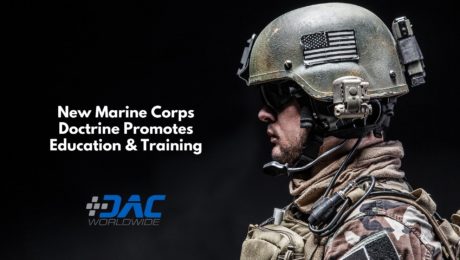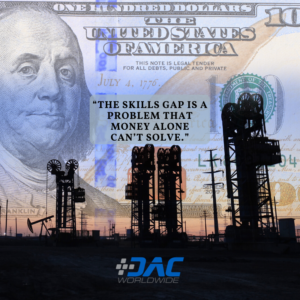Four Factors Contributing to the Oil and Gas Industry Skills Gap
Click HERE to view Four Factors Contributing to the Oil and Gas Industry Skills Gap as a multimedia presentation.
The COVID-19 pandemic and its continuing aftereffects have shined a spotlight on the job market in the United States. Unemployment numbers remain high, yet we see “Now Hiring” signs everywhere we look. What’s going on?
In many industries, there exists what is commonly called a “skills gap” that accounts for the number of open, unfilled positions. This gap refers to the difference between the number of highly-skilled workers that employers need and the number of such workers available.
Nowhere is the skills gap more noticeable than in the oil and gas industry. As Vivek Kumar notes in an IndustryWired article, “[m]any industry professionals believe that a growing skills shortage has been the biggest challenge for the industry.”
According to a Rand Corporation study, the industry will require a “projected 1.9 million future oil and natural gas workers.” Because of the skills gap, hundreds of thousands of those positions could remain unfilled.
In this article, we’ll take a look at four factors contributing to the oil and gas industry skills gap, including an aging workforce, advanced technologies, reluctant millennials, and training challenges specific to the oil and gas industry. We’ll also examine the role training plays in bridging the skills gap, as well as how Bayport Technical’s training solutions prepare workers for success in the oil and gas industry.
An Aging Workforce Takes Critical Skills and Experience with Them When They Retire
 In an ideal world, aging employees close to retirement would help to train new, younger workers to take their place, passing along valuable knowledge accumulated from their years of experience on the job.
In an ideal world, aging employees close to retirement would help to train new, younger workers to take their place, passing along valuable knowledge accumulated from their years of experience on the job.
Unfortunately, that is not happening as frequently as it should in today’s oil and gas industry. Too many workers are reaching retirement age in the near future, and not enough new workers are filling open positions to replace them.
As noted by Jake Wengroff in a Synapse article, “[t]he average age of workers in petroleum companies is 50 years old, among the oldest of any industry…Now more than ever: with an increase in the number of experienced individuals retiring, the energy industry is facing a shortage of trainers capable of mentoring the next generation.”
A Grainger article summarizes the effect this is having on the oil and gas industry skills gap: “[m]any oil and gas companies have large segments of their workforce who are able to retire in the next few years. As these experienced workers leave, companies will have to bring in new employees and contractors who are less experienced and unfamiliar with the facility.”
New Technologies Are Transforming the Oil and Gas Industry
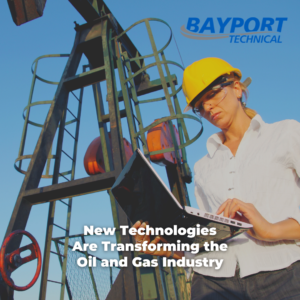 Adding to the skills gap problem is the fact that, according to Kumar, “[t]he oil and gas industry is rapidly moving towards digital transformation.” This is not surprising, as new technologies like artificial intelligence, data analytics, and the Internet of Things are transforming industries of all kinds around the world.
Adding to the skills gap problem is the fact that, according to Kumar, “[t]he oil and gas industry is rapidly moving towards digital transformation.” This is not surprising, as new technologies like artificial intelligence, data analytics, and the Internet of Things are transforming industries of all kinds around the world.
The result is that today’s oil and gas workers need more advanced skills than ever before. As Wengroff notes, “[e]xploration, refining, and distribution of oil and gas and alternative energy sources have become complicated processes, as new technologies are introduced to maximize production.”
Workers without the requisite skills must either be replaced or retrained. According to the Rand Corporation study, “[a]s manual skills become less valuable than the technological ones needed to operate the emerging forms of equipment that are characteristic of this sector, many workers with obsolete skills are being displaced.”
The Rand Corporation study concludes:
“The gap between employer needs and employee skills is widest in the near term, when more jobs will open up than the current output of graduates is likely to meet, retirements will increase among the baby-boomer generation, and reliance on technical skills in the workforce will continue to increase.”
The Oil and Gas Industry Is Having Trouble Attracting Millennials
 Attracting workers to the skilled trades has always been an uphill battle. Ask anyone in manufacturing and they will tell you it’s a constant struggle fighting misconceptions and negative perceptions of industry jobs.
Attracting workers to the skilled trades has always been an uphill battle. Ask anyone in manufacturing and they will tell you it’s a constant struggle fighting misconceptions and negative perceptions of industry jobs.
The oil and gas industry is no different. In fact, it probably faces even greater challenges than other industries, because many young people tend to perceive oil and gas jobs as hot, dirty, difficult, and even dangerous.
Clearly, if the skills gap is to be bridged, more effort must be made to increase the number of new workers choosing the oil and gas industry. As Kumar notes, “[c]reating job opportunities for young professionals can be an effective approach to lessen the shortage of talented workforce in the oil and gas sector.”
However, no one believes this task will be easy. In fact, there are even newer concerns to address when it comes to millennials and the oil and gas industry. According to Kumar, “[m]any reports reveal that millennials are tentative to make a career in the industry. This is significantly because of the concerns around the consistency of the industry in the future, contributing to a workforce shortage in the industry. As millennials are becoming more tech-savvy, they want to work in innovative and evolving green energy industries.”
The Oil and Gas Industry Has Unique Training Challenges
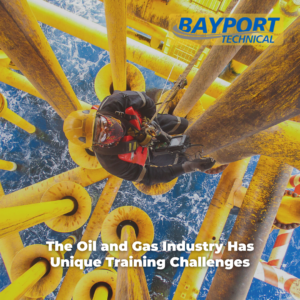 Further compounding the skills gap problem is the fact that the oil and gas industry has unique training challenges. This issue particularly comes into play when thinking about both upskilling incumbent workers and getting new workers up to speed with the skills they need to succeed.
Further compounding the skills gap problem is the fact that the oil and gas industry has unique training challenges. This issue particularly comes into play when thinking about both upskilling incumbent workers and getting new workers up to speed with the skills they need to succeed.
According to Kumar, “[t]he major reason the oil and gas industry faces skills deficiency are numerous training challenges, including regulatory compliance mandates, training costs to an aging workforce and the need to improve production rates while reducing environmental impacts and safety accidents.”
Wengroff points out that, “[a]s the energy industry grows more significant, and new participants enter the value chain, training is vital.” However, the author notes that this doesn’t mean training gets the attention it deserves, because “[s]pending time in instructor-led training sessions takes away from engineering, design, exploration, distribution, or retail marketing activities.”
Wengroff concludes:
“As with other industries, energy companies face a shortage of resources allocated to training. This may seem paradoxical, given the multi-trillion-dollar size of the oil, gas and alternative energy industry. However, with most funds going to exploration or the development of new technologies for extraction, refining, and distribution, training budgets are considered overhead and are often greatly reduced in size.”
Effective Training Can Bridge the Oil and Gas Industry Skills Gap
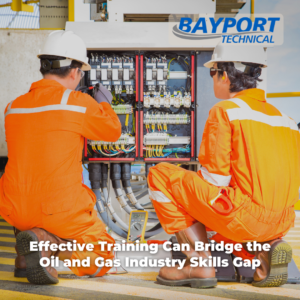 As we’ve discussed, there are multiple factors contributing to the oil and gas industry skills gap problem. How do you solve a lack of highly-skilled workers? The obvious solution is to ensure that prospective and current workers have the advanced technical skills they need.
As we’ve discussed, there are multiple factors contributing to the oil and gas industry skills gap problem. How do you solve a lack of highly-skilled workers? The obvious solution is to ensure that prospective and current workers have the advanced technical skills they need.
Of course, putting that “simple” solution into practice is never as easy as it sounds. For example, many employers fail to invest in proper training because they feel like that responsibility should fall on the shoulders of educators at the secondary and post-secondary level.
However, that attitude won’t get you far in the oil and gas industry. With unique safety and regulatory compliance issues aplenty, the oil and gas industry simply cannot ignore the need for effective on-the-job training.
Consider these figures from the Rand Corporation study:
“About half of employers (52 percent) reported employing high-priority occupations that require moderate-term on-the-job training (including inspectors, welders, and roustabouts) and about one in four employers (28 percent) reported having high-priority occupations that require long-term on-the-job training (including mechanics, machinists, and wellhead plumbers). Thus, for many…oil and gas sector employers…it is essential to invest in and commit to providing on-the-job training to ensure their workers can adequately perform their duties.”
Moreover, it’s clear that prospective and current employees want and value ongoing training opportunities. Wengroff discusses this fact in his article:
“According to research conducted by the Society of Petroleum Engineers, employees place a great emphasis on training opportunities when choosing employers. According to the SPE survey, three-quarters (74.6 percent) of employees state that learning and development programs are important in their choice of role, and over half (53.3 percent) indicate that a lack of opportunities would be enough for them to consider leaving the company.”
In addition to being wanted and valued by current and future workers, ongoing training is simply necessary. As the Rand Corporation study notes, “training requires an investment on the part of the employer, as many elements of jobs and their corresponding duties are not directly taught in the classroom — even in occupationally focused courses/degree programs.”
Rather than viewing ongoing training as a cost to be managed, oil and gas companies would do well to instead think of training as an opportunity to invest in its workers. Using an analogy uniquely appropriate to the oil and gas industry, the Rand Corporation study concludes:
“Focusing on the workforce as a pipeline that supports careers rather than a single hiring transaction at entry is essential for sustaining the oil and natural gas industry over the long term. Put differently, the contours of workers’ careers will evolve over time, requiring additional training, guidance, support, and (in some cases) additional degrees or certifications. Focusing only on the education, knowledge, and skills that workers gain from school and bring with them to their jobs is potentially short-sighted.”
Bayport Technical Can Help You Bridge the Oil and Gas Industry Skills Gap
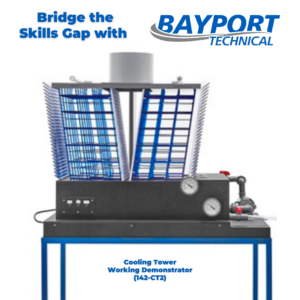 Starting a new skills training program can be challenging for any company. This is especially true in the oil and gas industry with its specialized equipment and regulatory compliance issues. That’s why it’s essential to get help from a trusted technical training expert.
Starting a new skills training program can be challenging for any company. This is especially true in the oil and gas industry with its specialized equipment and regulatory compliance issues. That’s why it’s essential to get help from a trusted technical training expert.
If you want to take your oil and gas training to the next level, contact the experts at Bayport Technical today. Bayport Technical features a wide variety of oil and gas training solutions, including trainers and working demonstrators.
You’ll find training aids designed specifically for the unique requirements of the oil and gas industry, including solutions providing training with specialized equipment such as flash drum separators, 3-phase separators, storage wells, cooling towers, floating roof tanks, and more.
The experts at Bayport Technical can help you design a training program that addresses the specific needs of your organization. With years of experience providing training solutions to the oil and gas industry, Bayport Technical knows how to help you develop effective training that will provide your workers with the skills they need to succeed.
- Published in News
New Marine Corps Doctrine Promotes Education & Training
Click here to view New Marine Corps Doctrine Promotes Education & Training as a multimedia presentation.
The few. The proud. Who are we talking about? The Marines, of course. That particular recruiting slogan has been permanently etched into our memories over the years.
And it’s a great slogan. The Marines are legendary for a training regimen that weeds out all but the strongest, creating a fighting force to be reckoned with. Indeed, the Marines have been on the front lines of every major U.S. military campaign of the modern era.
To be prepared for the future, however, the Marines know that training the same way they have in the past will not be sufficient. That’s why a recent doctrinal publication puts a new focus on education and continued learning.
Industry, always closely connected to the military, would do well to put a renewed emphasis on education and training, too. In this article, we’ll take a closer look at how partnering with a trusted technical training company like DAC Worldwide can prepare your students, workers, soldiers, and sailors for a bright future.
A New Doctrine for a New Era
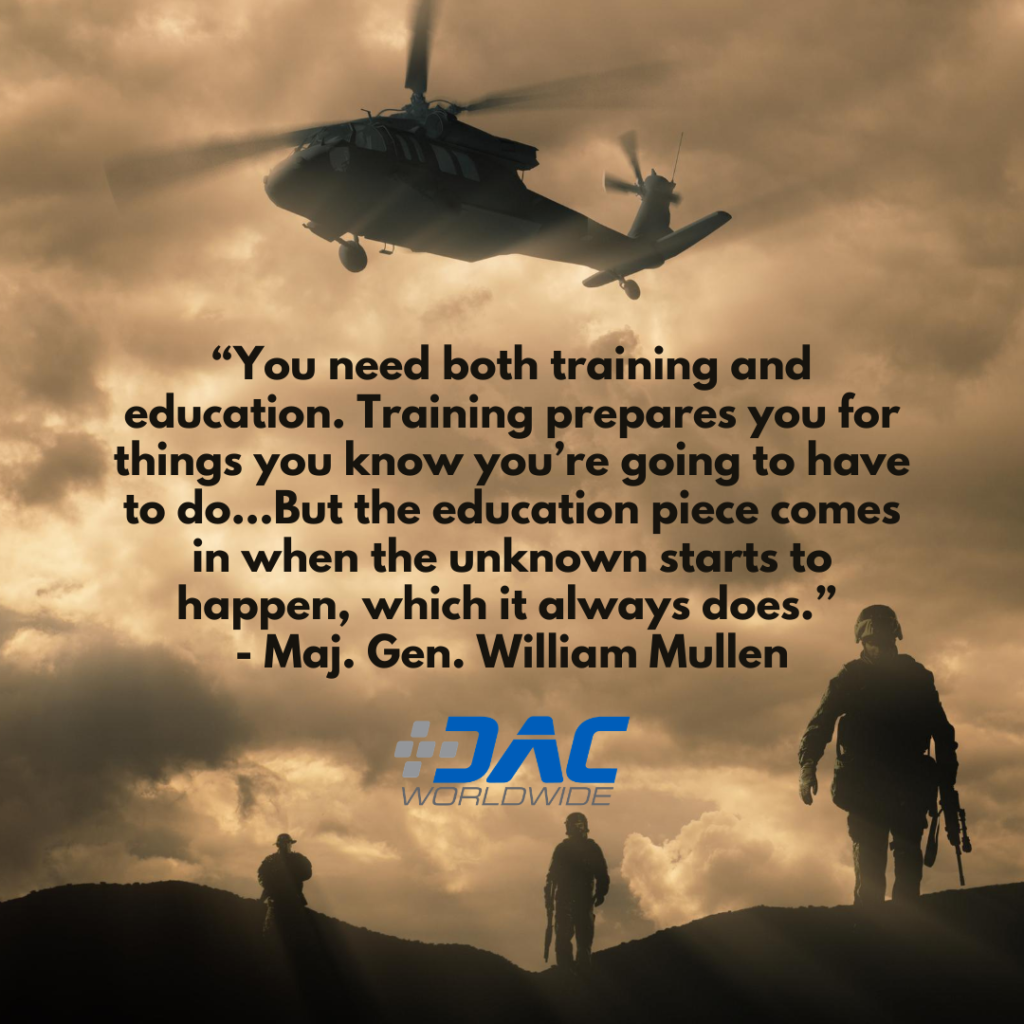 According to a Marine Corps Times article, “the Marine Corps unveiled the Marine Corps Doctrinal Publication 7 [MCDP 7] in February [2019] as the service aims to promote education, training, and continued learning among Marines so they become students of their profession.”
According to a Marine Corps Times article, “the Marine Corps unveiled the Marine Corps Doctrinal Publication 7 [MCDP 7] in February [2019] as the service aims to promote education, training, and continued learning among Marines so they become students of their profession.”
How significant was this doctrinal development? MCDP 7 was the first new doctrinal publication issued by the Marines since 2001. Its goal: “to motivate Marines to personally assess where they can improve and understand the ‘why’ behind the significance of learning.”
Maj. Gen. William Mullen was quoted as saying “that he’s heard Marines say they joined the service to escape an academic education. But the Corps wants its personnel to understand that the two complement one another and that education prepares Marines to think quickly when faced with challenges.”
According to Mullen, “You need both training and education. Training prepares you for things you know you’re going to have to do…But the education piece comes in when the unknown starts to happen, which it always does.” Mullen specifically referred to the fact that the environments Marines face today present challenges that are only growing more complex.
This new doctrinal change comes as “Commandant of the Marine Corps Gen. David Berger is working to remake the Corps to better compete with potential high-end adversaries…Berger wants a leaner force to conduct sea denial operations, survive in a contested maritime environment and serve as a larger Naval expeditionary force.”
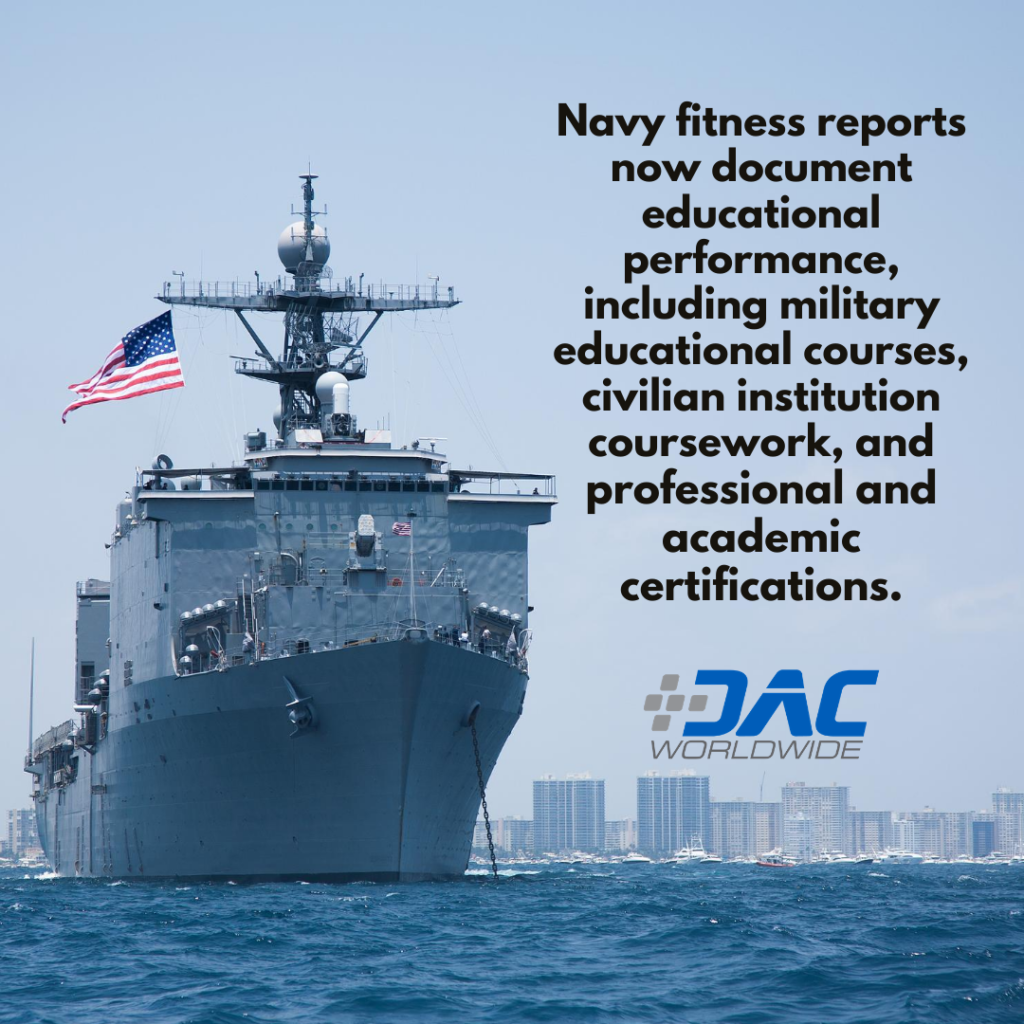 It’s Not Just the Marines
It’s Not Just the Marines
Speaking of the Navy, the Marine Corps Times article notes that the Navy announced in May 2019 “that it was modifying fitness reports to reflect an individual’s educational and training accomplishments, including military education courses, professional and academic certifications, among other things.”
Like the Marines’ new focus on education and continued learning, the Navy’s modified fitness reports are meant to “show that career-long military learning isn’t only job-related technical or tactical training, and that a commitment to higher education will produce Navy leaders with more refined critical thinking skills,” according to an article in the Navy Times.
Future Navy fitness reports will thus document educational performance, including “[m]ilitary educational courses, civilian institution coursework, and professional and academic certifications.” Navy leadership also indicated they will also encourage additional informal efforts, such as learning new technologies.
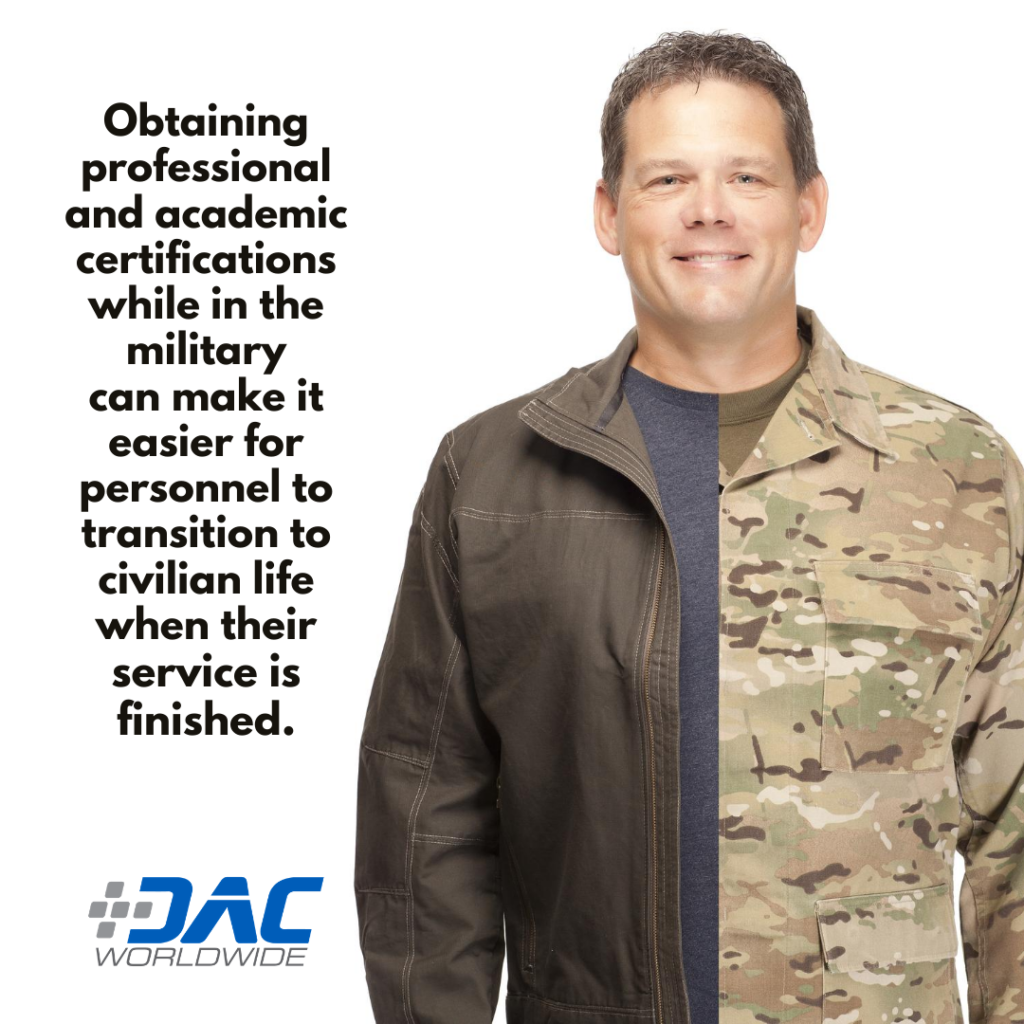 It’s All COOL
It’s All COOL
It’s no coincidence that the Marines and the Navy would emphasize professional and academic certifications. Much of the training that military personnel receive prepares them for future civilian jobs.
Obtaining professional and academic certifications while in the military can make it easier for personnel to transition to civilian life when their service is finished. All branches of the military recognize the importance of certifications in making that transition as easy as possible.
For example, the Marine Corps COOL site (Marine Corps Credentialing Opportunities On-Line) helps Marines see how their military training and experience matches up with civilian credential requirements. Such credentials could include important and valuable advanced manufacturing credentials from entities like the National Institute of Metalworking Skills (NIMS) and the Manufacturing Skill Standards Council (MSSC).
Marines using the COOL site can see whether military funding is available to help attain particular credentials. They can also see how the training and skills they’ve already acquired might match up with specific credentials valued by employers, such as NIMS’ Industrial Technology Maintenance (ITM) certification or MSSC’s Certified Production Technician (CPT) certification. There are also COOL sites for the Army, Coast Guard, Navy, and Air Force.
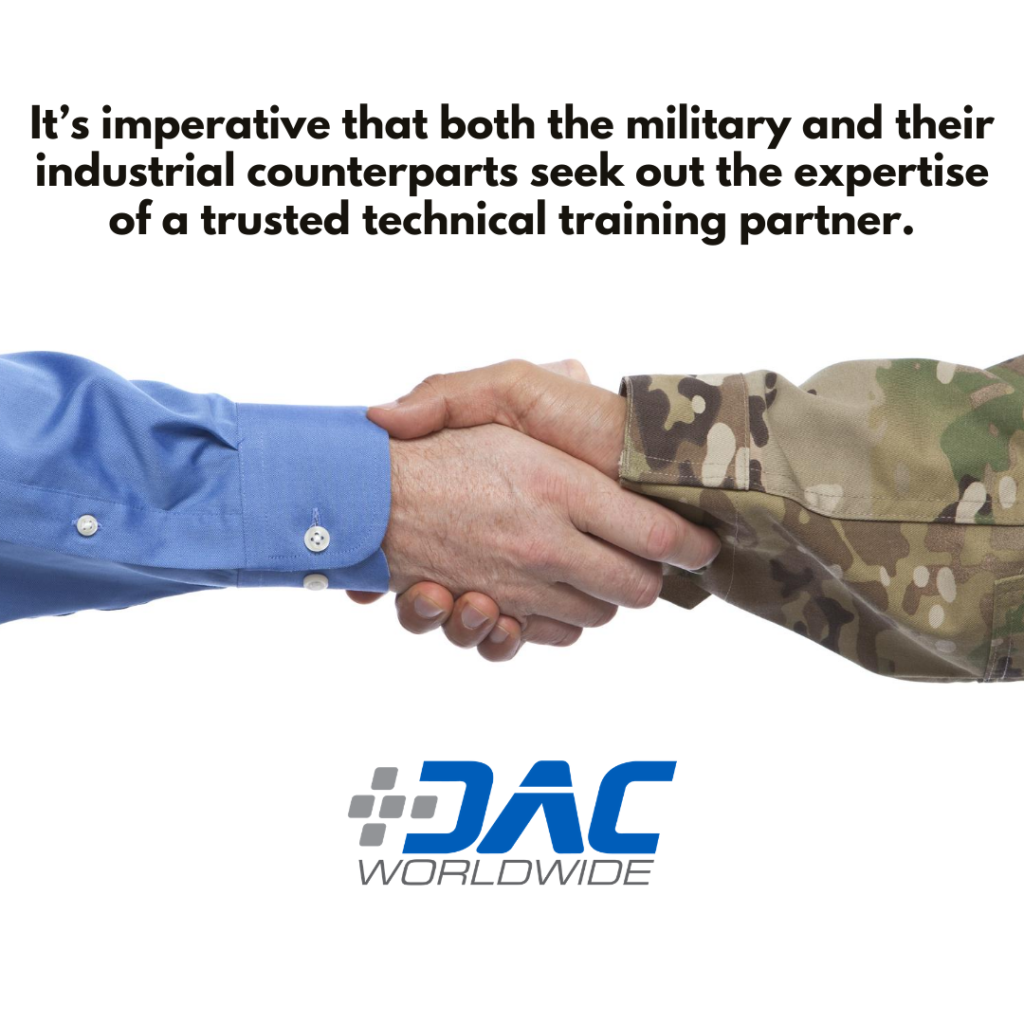 Industry Must Also Evolve
Industry Must Also Evolve
Given the military’s new focus on education and continued learning, it’s important that industries that work with and support the military evolve in a similar fashion. The military-industrial complex consists of all sorts of industries that work closely with the military to help them accomplish their mission.
These industries should take a cue from their military counterparts and begin to develop a similar focus on education and continued learning among their workforce. Industry workers will only be able to continue to keep pace with their military counterparts if they’re also seeking new educational opportunities and learning new skills and technologies.
Pushing an industrial workforce or a military organization toward more education and greater skill development can be a daunting task. That’s why it’s imperative that both the military and their industrial counterparts seek out and rely upon the expertise of a trusted technical training partner.
A Trusted Education & Training Partner
DAC Worldwide is a US-based world leader in technical training solutions. For over 35 years, DAC Worldwide has been helping industrial employers and military organizations with realistic, hands-on training systems.
DAC Worldwide offers a wide range of product solutions to fit all your training needs. From training systems that teach a full range of skills to cutaways that increase understanding of how a component works, we have what you need.
For example, many military personnel work in the same skilled occupations as civilians. This means they need a solid foundation in various technologies, including electrical, electronics, fluid power, and mechanical drives.
Whether you train military personnel working on military bases or civilian crews with military contracts, DAC Worldwide’s military training solutions offer an unmatched range of products to allow you to create the course you need or to fill in any gaps that you have in your current training.
Let’s take a closer look at four specific DAC Worldwide products that can take your training program to the next level:
Lock-Out/Tag-Out Training System (811-000)
DAC Worldwide’s Lock-Out/Tag-Out Training System features a realistic, simulated working process environment that facilitates introductory training with hands-on activities related to the process of identifying and locking out sources of dangerous potential energy in an industrial setting. The training system includes two process tanks; a centrifugal pump; a complex, multi-purpose piping network; electrical controls; a variety of lockable system components; and a lock-out/tag-out kit that features a large number of commonly-encountered locking and tagging devices.
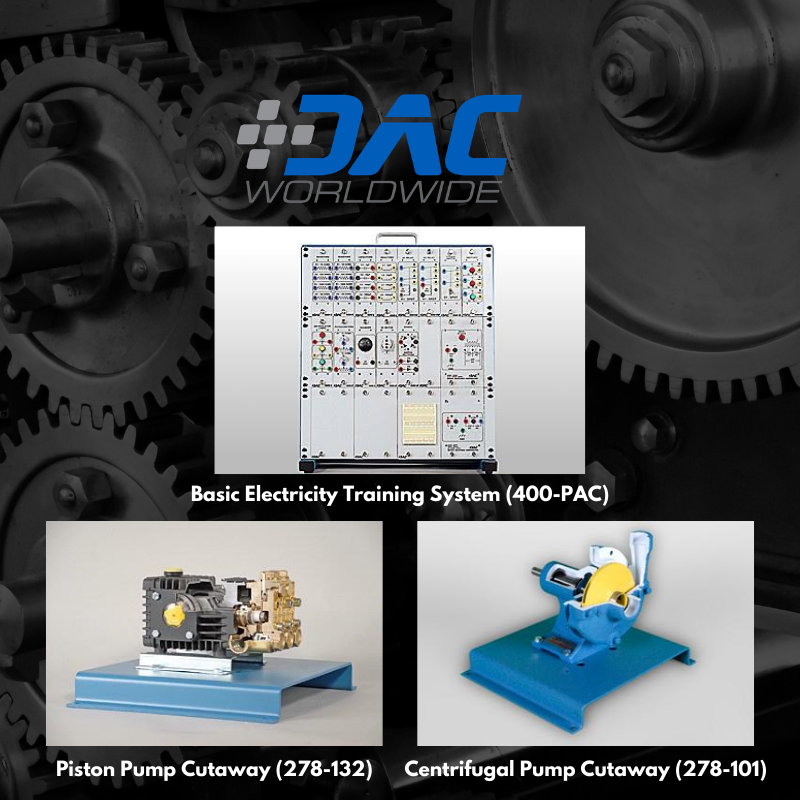 Basic Electricity Training System (400-PAC)
Basic Electricity Training System (400-PAC)
DAC Worldwide’s Basic Electricity Training System teaches basic AC and DC electrical principles. Learners will explore how electricity is used for power and control in various sectors. The trainer covers industry-relevant skills, such as installing, operating, and troubleshooting AC and DC electrical circuits in a variety of applications.
Piston Pump Cutaway (278-132)
DAC Worldwide’s Piston Pump Cutaway is an industrial piston pump that has been carefully sectioned and color-coded to train learners in the design, operation, construction, and maintenance of this common process pump used throughout industry. The cutaway exposes and showcases the complete internal configuration of an industrial piston pump. Moreover, seal features and bearings have been retained to allow realistic, hands-on pump maintenance and operation training.
Centrifugal Pump Cutaway (278-101)
DAC Worldwide’s Centrifugal Pump Cutaway is a sectioned centrifugal pump that provides realistic training in the operating principles, construction details, and maintenance of common centrifugal process pumps used throughout industry and the military. It includes various sectioned components, such as seals and bearings, as well as showcasing the pump’s impeller.
Contact DAC Worldwide Today
Is your organization ready to take its industrial technical training to the next level? Contact a DAC Worldwide expert today for a personal consultation regarding your training needs and how our variety of training systems, cutaways, dissectibles, and models can prepare both industrial workers and military personnel for the future challenges they face.

- Published in News
Bridging the Oil and Gas Skills Gap: Effective Technical Training for Current and Future Employees
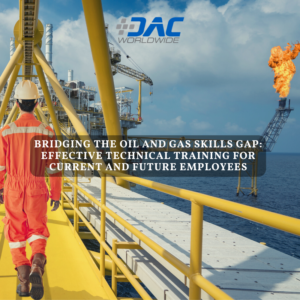 Click HERE to view Bridging the Oil and Gas Skills Gap: Effective Technical Training for Current and Future Employees as a multimedia presentation.
Click HERE to view Bridging the Oil and Gas Skills Gap: Effective Technical Training for Current and Future Employees as a multimedia presentation.
What does 2020 and the coming years hold for industries around the globe? That’s the question on the minds of many executives as they embark on a new year and a new decade. For the oil and gas industry, a skills gap will continue to create problems for employers looking to seize new opportunities for increased efficiency and profitability. Effective technical training for current and future employees will be a key strategy necessary to solve this problem.
In this article, we’ll take a closer look at what 2020 holds for the oil and gas industry, including the reasons behind and current state of the skills gap in the industry. We’ll consider how companies are using training programs to upskill current workers and ensure future workers have the skills they need. Finally, we’ll look at how DAC Worldwide’s unique oil and gas training tools can help employers and educators to bridge the skills gap facing the oil and gas industry.
2020: Opportunities and Challenges
The oil and gas industry has rebounded from the economic downturn experienced several years ago. According to Deloitte’s 2020 Oil, Gas, and Chemical Industry Outlook, there are several reasons for optimism in the new year: “Liquid natural gas (LNG) keeps growing…[f]ossil fuel consumption is expected to continue to grow…[and] [g]lobal…oil supply remains secure thanks to growing US production and healthy stocks.”
The Deloitte report concludes that oil and gas executives need to be “ready to embrace new opportunities for profitable growth…Thanks to the lessons learned from the most recent boom and bust cycle, the industry is better equipped to face the future than it has been at any other point in the past decade. Still, there are fundamental, long-term challenges that they will have to face.”
The 2019 Global Energy Talent Index (GETI) Report agrees, noting that “[t]he oil price has rebounded and new projects are on the rise. The challenge now for the sector is to ensure that the talent supply can keep up with demand.” Why? Quite simply, “[m]aintaining a pipeline of new talent has become a challenge for oil and gas companies.”
The Oil and Gas Skills Gap
A recent Energy Sourcing article notes that, in the coming decade, the “U.S. Bureau of Labor Statistics expects 54.8 million total job openings [in the oil and gas industry],” but there are “not enough skilled people to fill them.” What is behind this skills gap? Experts point to a variety of factors that have contributed to the growing shortage of skilled talent in the oil and gas industry.
Too Few Millennials, Too Many Boomers
According to the 2019 GETI Report, “the impact of economic cycles on job stability is a leading cause of the skills shortage.” During the recent economic downturn, jobs were cut and recruitment efforts were severely curtailed. The result has been the slowing of “[t]he influx of young talent into the sector,” leading to the present “talent crunch.”
Now that the industry is back on the upswing, employers are trying once again to attract young talent, but they’re finding it’s not as easy as it used to be. As a recent Airswift article notes, oil and gas employers are learning a hard lesson: “The skills gap is a problem that money alone can’t solve.”
Not only is oil and gas “the number-one industry millennials wished to avoid working in because of its image,” but competition for young, skilled talent is fierce because the skills gap affects nearly every industry around the world.
Adding to the problem of the short supply of young talent is the fact that “[o]lder workers from the Baby Boomer generation are beginning to reach retirement age, ultimately heading off and taking decades of knowledge and experience with them.” Who will replace them?
 Industry 4.0 Changes
Industry 4.0 Changes
Whoever does replace retiring workers will have to possess a stronger technical skillset than ever before. In addition to skills specific to the oil and gas industry, they will need advanced technological skills that will enable them to succeed as the industry experiences the dramatic changes characteristic of the Fourth Industrial Revolution, otherwise known as Industry 4.0.
Industries across the board and around the world are being impacted greatly by Industry 4.0’s technological advances. Oil and gas is no exception. As the Airswift article notes, “oil and gas companies are collecting more and more digital data which is helping to improve worker safety, monitor reservoir behaviour, plan ahead for smoother digs, maintain hardware and much more.”
They’re also incorporating new technologies, such as drones. According to the Oil and Gas Drone Services Market – Growth, Trends, and Forecast (2019-2024), the market for drone services in the oil and gas industry is expected to grow by more than 60% in the next five years.
As a Business Wire article summarizing the drone forecast notes, “[d]rones are being used for inspection to determine any damage or corrosion and to provide data for structural integrity and visual and infrared photography,” as well as for “pipeline inspection, corrosion checks, security checks, and maintenance issues.”
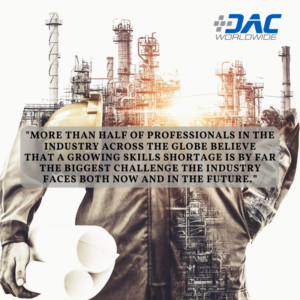 Positions Aplenty
Positions Aplenty
In addition to new positions, such as drone pilot and drone fleet manager, the oil and gas industry features a wide range of high-priority roles impacted by the skills gap. According to a recent study by RAND Corporation, the sector needs plenty of “lease operators (also known as well tenders), equipment operators, maintenance and service technicians…electrical engineers…welders, pipeline layers…commercial drivers…machinists [and] warehouse operators.”
The 2019 GETI Report also notes that “the pool of available, blue-collar talent has shrunk rapidly. These skills are proving to be the most urgent of needs…In the US, blue-collar skills are more in demand than engineering roles.”
The Airswift article summarizes things succinctly:
“There is a very real problem standing on the doorstep of oil and gas companies, and it is one that needs a huge amount of effort and foresight to solve for long-term growth and success. We’re talking about the industry skills gap which is crippling energy companies, holding up work and causing projects to go over budget…More than half of professionals in the industry across the globe believe that a growing skills shortage is by [far] the biggest challenge the industry faces both now and in the future.”
Technical Training to the Rescue
As the Airswift article makes clear, oil and gas companies are learning that the skills gap is a problem that won’t go away just by throwing money at it. It requires a multifaceted approach with coordination between a variety of stakeholders, including employers, educators, workforce development programs, and even local, state, and federal governments.
 Ongoing Training Is Key
Ongoing Training Is Key
While long-range plans are set into motion, employers still must do what they can in the meantime. Airswift notes that the 2019 GETI Report’s survey found that nearly two-thirds of respondents believe “companies should be turning their attention internally and retraining existing employees to deliver the skills they need to bridge the gap.”
The author of the Energy Sourcing article agrees: Training current and new employees with cross-functional skills “may be the quickest answer to the industry’s current hiring challenges.” Another strategy many employers consider is luring skilled talent away from other industries.
However, bringing in people from other disciplines isn’t a “plug and play” phenomenon. Instead, the Energy Source article points out that “when it comes to the required knowledge to be proficient in oil and gas exploration and development, they will need additional training in certain areas to enter this industry ready to be contributing members of the team.”
The oil and gas industry differs from other industries in that the wide variety of specialized skillsets it requires make initial and ongoing internal training a necessity. Two recent studies reveal the nature of this need.
The RAND Corporation study concludes:
“About half of employers (52 percent) reported employing high-priority occupations that require moderate-term on-the-job training (including inspectors, welders, and roustabouts) and about one in four employers (28 percent) reported having high-priority occupations that require long-term on-the-job training (including mechanics, machinists, and wellhead plumbers). Thus, for many of the oil and gas sector employers…it is essential to invest in and commit to providing on-the-job training to ensure their workers can adequately perform their duties.”
Similarly, SPE Research’s Training and Development Survey notes that “[u]pon starting a career [in the oil and gas industry], the majority (86.8%) of employees require training…[and] “[n]early a fifth (19.2%) required extensive training”…[and] [m]ost (82.4%) expect their employer to provide them with some of this training.”
 More Than a Short-Term Solution
More Than a Short-Term Solution
The RAND Corporation study goes on to explain that training is much more than just a short-term solution:
“[A] sizeable number of high-priority occupations require long-term training…underscor[ing] the need for ongoing training and professional development after hiring to ensure that employees are getting training both for the jobs they currently have and for the jobs they might take in the future. Focusing on the workforce as a pipeline that supports careers rather than a single hiring transaction at entry is essential for sustaining the oil and natural gas industry over the long term.”
The SPE Research survey also makes a strong case for focusing on employee training as a means of not only empowering employees with the skills they need but also meeting their expectations for career development: “Overall, a wide range of skills are important for a successful career in the oil and gas industry; therefore employees place great emphasis on training and development opportunities when choosing their employers.”
The survey notes that “[i]t is important for companies to have good training and development programs, as three-quarters (74.6%) of employees state that it is important in their choice of role, and over half (53.3%) say that a lack of opportunities would be enough for them to consider leaving.”
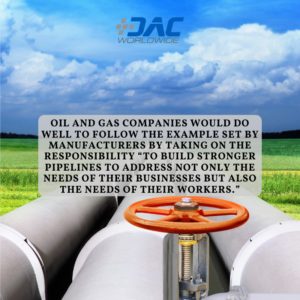 Gaining Momentum
Gaining Momentum
It appears employers are getting the message, since “[e]ight out of ten companies provide at least some formal training as their overall approach to employee development,” and “[t]echnical training is the most common form of training provided by employers.”
This response is being echoed by other industries, including advanced manufacturing. For example, The Manufacturing Institute Training Survey recently made these key findings regarding training programs in the advanced manufacturing sector:
- “Nearly 70% of manufacturers are addressing the workforce crisis by creating and expanding internal training programs for their workforce, among other tactics.”
- “More than 79% of respondents said that they have increased their training activities.”
- “Three-quarters of respondents said that upskilling workers helped to improve employee productivity, with promotion opportunities and morale also leading the list of reasons why companies might embrace training programs.”
- “In dollar terms, the Institute estimates that the sector spent at least $26.2 billion in 2019 on internal and external training programs for new and existing manufacturing employees.”
Oil and gas companies would do well to follow the example set by manufacturers by taking on the responsibility “to build stronger pipelines to address not only the needs of their businesses but also the needs of their workers.”
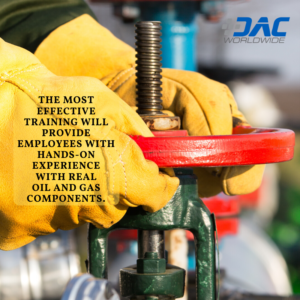 Quality Matters
Quality Matters
What kind of training is necessary? The answer to that question will vary widely amongst oil and gas companies. Is your company upstream, midstream, or downstream? What roles are you having trouble filling because of the skills gap?
What will not change from company to company is the need for high-quality training that efficiently and effectively teaches current and future employees the skills they need to succeed on the job. This is particularly true for the oil and gas industry, given its broad scope of roles with specialized skill requirements.
Unfortunately, many training programs don’t meet the needs of the oil and gas industry. As the RAND Corporation study notes, “[l]ess than half of courses aimed at future workers in the oil and natural gas industry use contextualized instruction. Contextualized instruction uses occupational applications to teach basic academic skills (and vice versa) in such a way that the student learns both simultaneously.”
Teaching relevant skills in the context of the oil and gas industry is especially important because the industry is unique in so many ways. The most effective training will provide employees with hands-on experience with real oil and gas components. The RAND Corporation study supports this approach: “past research shows that contextualized instruction is an effective approach to teaching occupationally focused students…particularly when it includes ‘real-world’ simulations of workplace situations with actual workplace equipment.”
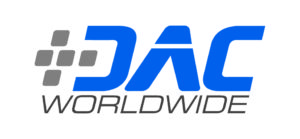 DAC Worldwide: Your Source for Effective Training Tools
DAC Worldwide: Your Source for Effective Training Tools
Oil and gas companies don’t need to recreate the wheel when looking for quality, effective technical training tools. Instead, they can rely upon a trusted training partner like DAC Worldwide to provide the guidance they need.
DAC Worldwide offers a wide variety of technical training tools specifically for the oil and gas industry. Importantly, these tools provide the contextualized, hands-on training current and future employees expect, want, and need.
Contact a DAC Worldwide representative to consult with you regarding your specific training needs. In the paragraphs that follow, we’ll take a look at just a small sample of the many training tools offered by DAC Worldwide, including training systems, cutaways, dissectibles, models, and sample boards.
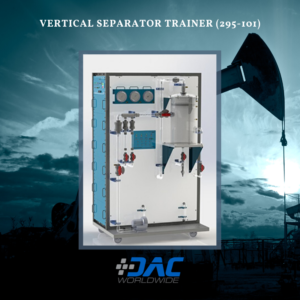 Training Systems
Training Systems
Rather than broad-based training in multiple areas, DAC Worldwide’s training systems provide hands-on training focused on specific tasks. This makes them particularly helpful to employers for skill assessment (either pre-employment or for upskilling purposes).
For example, DAC Worldwide’s Vertical Separator Trainer (295-101) consists of a reduced-scale, three-phrase vertical separator that mimics its real-world counterpart by using alternate production stream components, refined oil, air, and water. It also features real industrial components, such as on-board supply pumps, a regenerative blower, a static mixer, metered valves, flowmeters, an inlet diverter, overflow weir, mist eliminator, and a custom-fabricated, large-diameter, clear acrylic, vertical separator vessel.
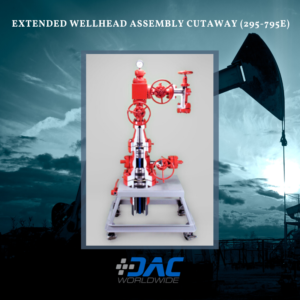 Cutaways
Cutaways
DAC Worldwide’s industrial component cutaways provide hands-on experience with real, industrial components that have been professionally sectioned to expose key internal components to help learners understand how they work. For industrial training relevance, common models by well-known manufacturers are chosen when manufacturing cutaways.
There are two dozen cutaways related to oil production to choose from, including a wide variety of regulators, valves, and gauges. For example, the Extended Wellhead Assembly Cutaway (295-795E) consists of a full-size, fully-detailed example of a high-pressure wellhead assembly that gives learners a first-hand view into a component found in oilfield applications worldwide. It features a variety of real industrial components learners will encounter on the job, including a casing head/starter head, tubing head, tree bonnet adapter, adjustable choke, and gate-type block valve.
 Dissectibles
Dissectibles
DAC Worldwide’s dissectibles take cutaways to the next level by allowing learners to disassemble and reassemble real industrial components. There’s simply no better way to train someone on the maintenance of a particular component than letting them disassemble and reassemble an actual unit. Plus, dissectibles provide experience with real components without damaging actual equipment.
For example, the Representative Triplex, Plunger Mud Pump Dissectible (295-418) is an economical, conveniently-sized triplex plunger-type mud pump assembly that teaches learners hands-on maintenance activities commonly required on larger mud pump assemblies used in upstream oilfield production operations. DAC Worldwide’s dissectible mud pump is a realistic sample that’s similar in geometry, design, and operating characteristics to the larger varieties learners will encounter on the job.
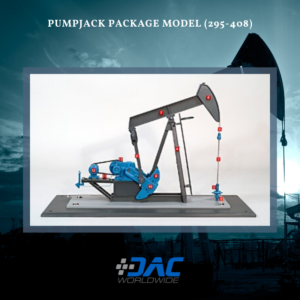 Models
Models
DAC Worldwide also offers a variety of incredibly-detailed, intricately-crafted models. Sometimes industrial training tends to focus so intently on the details that learners can’t see the forest for the trees. Models allow students to learn how the parts of a system work together on a small, easily-managed model without the need for a field trip to an industrial site.
There are more than a dozen models related to oil production to choose from, including separators, tanks, turbines, pumps, and piping systems. For example, the Pumpjack Package Model (295-408) is a highly-detailed, professionally-crafted technical scale model of a common oilfield production pump. Fully-detailed, this benchtop model depicts all primary pump features including counterweights, double-reduction gearbox, walking beam, horse head, sampson post, prime mover, pitman arm assembly, and representative wellhead.
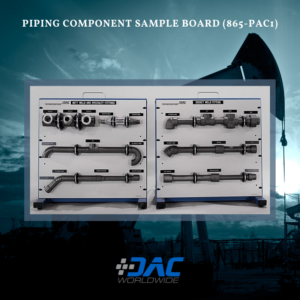 Sample Boards
Sample Boards
DAC Worldwide’s sample boards offer valuable maintenance training in the identification and selection of a variety of industrial components. Each sample board features a selection of real industrial components mounted with nameplates for easy association with individual components.
For example, the Piping Component Sample Board (865-PAC1) is a hands-on teaching aid designed to supplement courses in piping design, process operations, and pipe installation to help industrial maintenance technicians identify and select industrial piping components. Components from four common piping systems are provided. These samples represent a variety of piping system designs and include a broad range of fittings.
We encourage you to connect with DAC Worldwide via its social media channels, including YouTube, Instagram, LinkedIn, Twitter, and Facebook.
- Published in News


